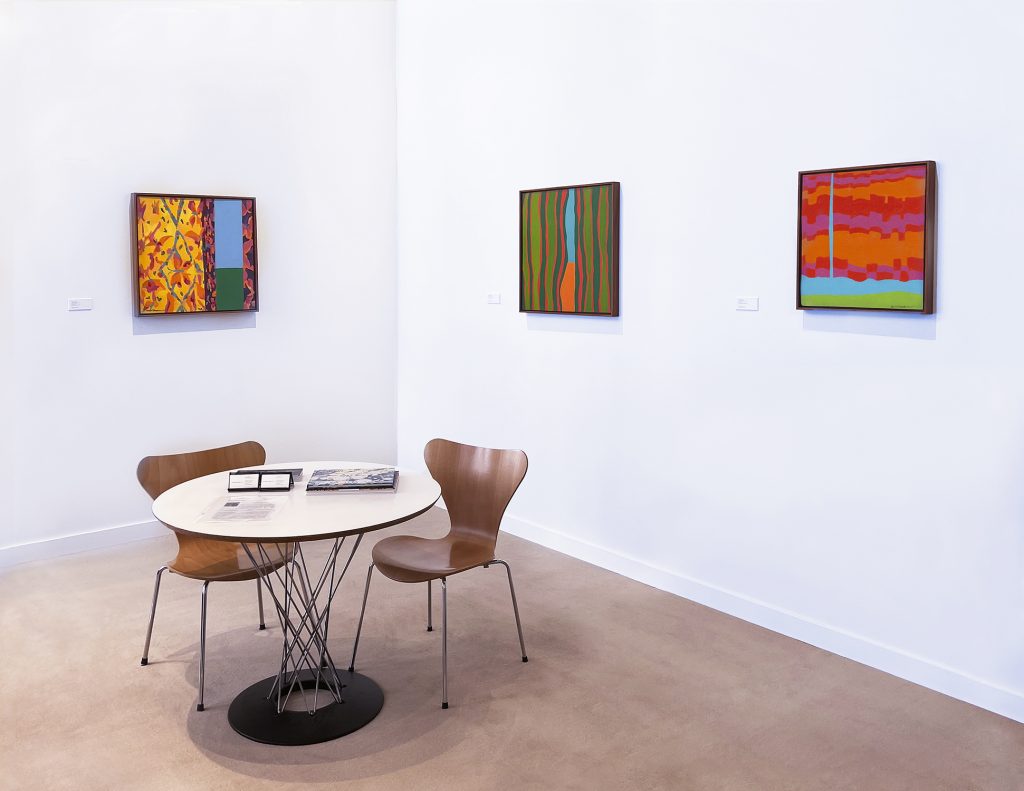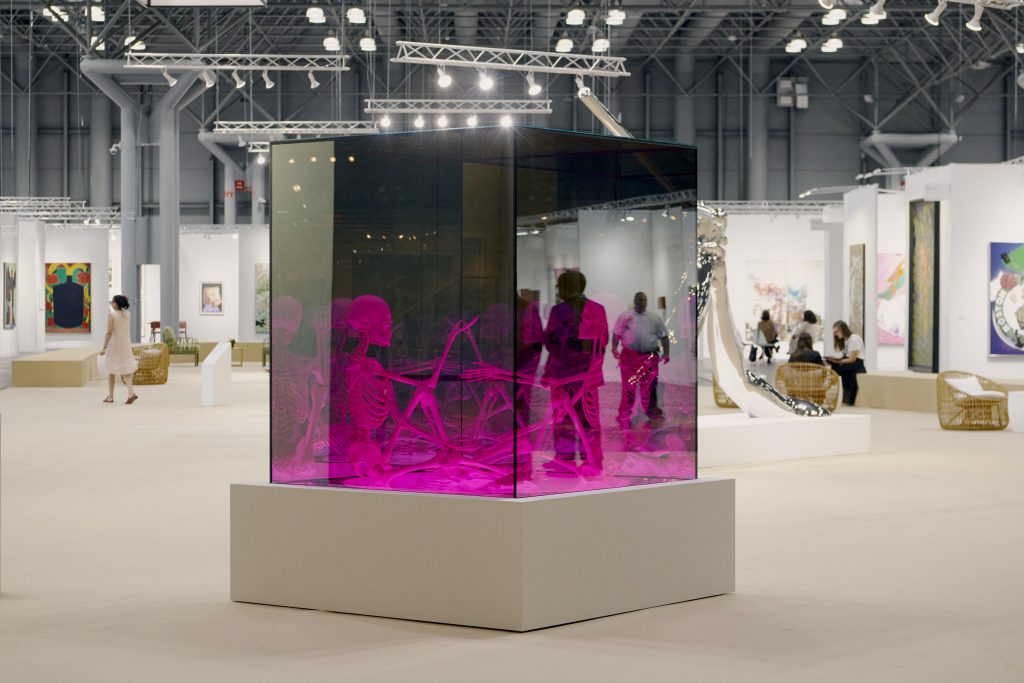The Art Detective
In a Jittery Market, a Glut of Art Fairs Is Again Putting Galleries Through the Wringer—With No End in Sight
Remember when a crammed calendar of global art fairs drove art dealers to desperation? Well, it's ba-aack.

Remember when a crammed calendar of global art fairs drove art dealers to desperation? Well, it's ba-aack.

Katya Kazakina

The back-to-school festivities known as Armory Week pushed the new art season into high gear in New York this week amid jitters over the market correction and uncertainty about the impact of consolidation in the trade-show industry.
It’s telling that much of the chatter in the aisles at the behemoth Javits Center, where the Armory Show opened to VIPs on September 7th, was about a totally different event taking place on the other side of the world—namely, Frieze Seoul, which started just a day earlier in South Korea, drawing away several key international galleries and forcing several others to double-down by participating in both events. The overlap between the two fairs resulted in a congested calendar at the start of the high-stakes season, when some fear a market bloodbath this fall could herald the end of three years of boom.
“We are going nuts,” said Mary Sabbatino, partner of Galerie Lelong & Co., which is participating in the Armory Show and Frieze Seoul while also—deep breath—doing a solo presentation at the Independent 20th Century art fair and an exhibition at its Chelsea gallery. All of this is happening this week.

An installation by Barthélémy Toguo in the Platform section at the Armory Show. Photo: Vincent Tullo
Juggling time, money, and artworks for these competing events is not entirely unfamiliar terrain for the art world. We’ve been here before—and not that long ago. Art fairs became ubiquitous in the 2010s, with some galleries routinely doing more than a dozen a year and occasionally bemoaning the financial and personal strain they caused. Then, three years ago, COVID-19 abruptly shattered international travel and live events. Getting together for air kisses and art commerce suddenly felt life-threatening. As fairs went online, some people swore they would not go back to the way things were.
But… here we are again. The fairs have roared back, and with vengeance, just as the art world is expanding beyond its traditional hubs. Hong Kong, which used to be the center of the art trade in Asia, is facing pressure from Seoul, which races to transform itself into a major destination on the art circuit.

A very crowded VIP day of Frieze Seoul 2023. Photo: Vivienne Chow.
At the same time, there’s consolidation. Art Basel, the biggest global art-fair brand, has become even bigger and shinier after subsuming a rival French fair known as FIAC. The new Parisian event that has resulted is quickly becoming a must for collectors around the world, and especially the Americans.
All of this is exciting—and complicated. Leaving aside the environmental concerns, the basic question is: How is it possible to do it all as a gallery, a collector, an advisor? And how can the big brands like Art Basel and Frieze continue expanding without diluting and cannibalizing themselves? Many Americans, for example, skipped Art Basel’s flagship fair in June because they were oversaturated from all the events in May in New York and wanted to hold out until Paris + par Art Basel in October.

Galerie Lelong presented paintings by Mildred Thompson at the Independent 20th Century art fair. Courtesy: Galerie Lelong
Consider the simultaneous timing of the Armory Show and Frieze Seoul—a calendar conflict that is made even more bizarre by the fact that both events are now owned by the same company, Endeavor Group Holdings, the talent agency and operator of events in sports, fashion, and entertainment. Endeavor, which has owned Frieze since 2016, recently went on a shopping spree, adding two U.S. art fairs, Armory Show and EXPO Chicago, to its portfolio.
Endeavor acquired the Armory Show, a legacy brand dating back to 1913, from Vornado Realty Trust for $24.4 million in July. (That price wasn’t disclosed, but because both companies are publicly traded, the Art Detective unearthed it this week in Vornado’s regulatory filings.) In May, Endeavor also paid $16.5 million to buy the remaining 30 percent stake of Frieze, which now produces art fairs in London, New York, Los Angeles and Seoul, from its founders, the company’s filings show.
(These prices seem like a steal next to the $9.3 billion Endeavor paid in April to acquire WWE, the professional-wrestling company.)
“The overlap is not ideal,” said Paul de Froment, managing partner at Almine Rech gallery, which is participating in both fairs as well as in the Independent 20th Century. “I am assuming they are going to try to change the dates.”

Galerie Lelong’s booth at Frieze Seoul 2023. Courtesy: Galerie Lelong
This hope was expressed by multiple exhibitors, who remain in the dark about the plans.
“While it is not ideal that the two fairs overlap in dates, they cater to different audiences and, as such, the crossover between galleries and collectors is minimal,” Simon Fox, the CEO of Frieze, said in emailed responses to the Art Detective’s questions. “Of course, it would be operationally easier if the fairs didn’t take place at the same time, but that depends on date flexibility at our respective venues.”
No changes are going to be made next year, a person familiar with the company’s plans told me. Frieze New York, which moved from a tent in Randalls Island to the Shed in Hudson Yards two years ago, is going to stay in the Shed. And the two September fairs will also remain in their unfortunate slots—though, Fox said, somewhat mysteriously, “there may be more opportunities to collaborate from early next year.”
“The Shed is cute, but it’s not functional,” said Lisa Spellman, owner of 303 Gallery, standing in a large booth at the Armory Show. “It’s hard to make significant sales when your space is 80 percent smaller than a normal booth.”
As for the New York/Seoul pileup, she found it a “distraction.”
“I know six galleries who would be here but couldn’t,” she said. In fact, the Armory show is down 15 participants from last year, with a total of 225 exhibitors this year. Those who used to be in the fair but are now doing Frieze Seoul include the heavyweights David Zwirner, Massimo De Carlo, and Sadie Coles. As a result, the New York fair feels less blue-chip this year.

A sculpture by Agnes Denes in the Platform section of the Armory Show. Photo: Vincent Tullo
All dealers are thinking hard about how to allocate resources at an uncertain time for the market, according to Galerie Lelong’s Sabbatino. “Every colleague I’ve talked to has definitely noticed that it’s more challenging,” she said.
After committing to Frieze Seoul and the Independent, Sabbatino herself initially declined to do a booth at the Armory Show—but then, acclaimed curator Eva Respini approached her to participate in the Platform section of large-scale artworks. The work Respini had in mind was a multi-element installation by Cameroon-and-Paris-based Barthélémy Toguo that had appeared at the Venice Biennale in 2015.
“It seemed like a great opportunity to show a significant work in good company and with an esteemed curator,” said Sabbatino. It was also a chance to promote the artist in the U.S., where he’s still not widely known.
There was another practical reason to seize the opportunity: The work, which consists of eight ladders and more than 100 large carved pieces of wood shaped as stamps, happened to be stored in New York. “If I had to ship it from Paris, I wouldn’t have said yes,” Sabbatino said.

A sculpture by Woody De Othello in the Platform section of the Armory Show. Photo: Katya Kazakina
Ben Brown, whose London gallery has branches in Palm Beach, Florida, and Hong Kong, believes that an ability to juggle overlapping fairs may come down to staff and geography. It’s cheaper to ship works from Hong Kong to Seoul than from London, for example—and he had staff to go to both fairs.
Even so, “we are overstretched,” he said. “There’s no salesperson at our London gallery at the moment.”
Another drawback: he would have liked to be in Seoul for the gallery’s debut at Frieze Seoul. But he had additional business commitments in the U.S.
“You have to choose,” he said. “I can’t be in two places at the same time.”